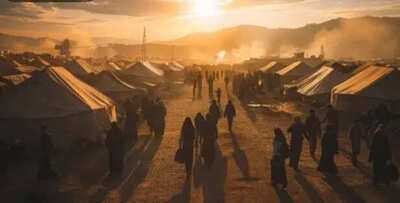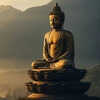
In the 3rd century BCE, Emperor Ashoka of the Mauryan Empire stood at the height of power. His dominion stretched from present-day Afghanistan to Bengal, from Kashmir to southern India. But it was one battle—the conquest of Kalinga in 261 BCE—that changed him more than all his victories combined.
The aftermath was not a celebration, but a reckoning.
In Ashoka’s own words, etched into rock and stone across the Indian subcontinent, he described his deep remorse at the suffering caused by war. These were not poetic flourishes—these were imperial proclamations of conscience, inscribed for his subjects to read. They are known as the Edicts of Ashoka, and they mark one of the earliest instances in world history where a ruler publicly renounced violence.
But more than personal guilt, these nightmares redefined Indian Buddhism itself—turning it from a largely monastic, ascetic path into a powerful civilizational force.
1. The Kalinga War: Ashoka’s Bloody Baptism

The year was around 261 BCE. The Mauryan Empire under Ashoka had expanded far and wide, but one territory remained defiant—Kalinga, in present-day Odisha. The war that followed was catastrophic. Ashoka’s own inscriptions admit the number of dead: over 100,000 slain, 150,000 deported, and countless left mourning.
But victory came at a terrible price.
In the 13th Rock Edict, Ashoka confesses:
“If anyone does wrong, it weighs heavily on the mind of Devanampriya [Ashoka]...”
His horror wasn’t strategic—it was spiritual. The scale of suffering broke something inside him. That fracture would become the space where Dhamma entered.
2. From Chakravartin to Dhamma-Raja: The Emperor’s Transformation

Traditionally, a
chakravartin (universal monarch) ruled through conquest. Ashoka turned this idea on its head. He sought to be a
dhamma-raja—a king who ruled by moral example, not military force. His nightmares had stripped him of imperial pride, and in its place grew humility.
This was unprecedented.
Ashoka’s Dhamma wasn’t orthodox Buddhism, but a radical moral code for rulers and commoners alike:
- Compassion toward all beings
- Respect for all sects and teachers
- Humane treatment of prisoners and animals
- Ethical conduct in speech and action
It was Buddhism for the people, not just monks in caves.
3. Ashoka’s Buddhism: Turning Inward to Turn the World Around

Before Ashoka, Buddhism was largely confined to monastic communities. The Buddha had taught in forests and villages, but the state remained distant. Ashoka changed that. His conversion wasn’t a retreat—it was an expansion of Buddhism into public life, law, policy, and global diplomacy.
He:
- Sent missions abroad, even to the Hellenistic world (Greece, Syria, Egypt)
- Built rest houses, hospitals, and wells along trade routes
- Commissioned stone pillars and edicts carved with moral guidance in local languages
This was the first time a state had institutionalized spiritual compassion. India had had sages and philosophers before—but never an emperor who ruled by repentance.
4. Ashoka’s Edicts: The Voice of a Haunted Conscience Ashoka didn’t preach from thrones. He engraved his remorse into stone.
His rock and pillar edicts are psychological relics, not just historical ones. They read like public therapy sessions of a man trying to make sense of his karma. For instance:
“Even a hundredth or thousandth part of the people who died... now weighs heavily on the mind of Devanampriya.”
These edicts were spread across the empire—from Kandahar in Afghanistan to Andhra Pradesh—broadcasting a new kind of kingship: one rooted in self-awareness and ethical restraint.
It was the political equivalent of
vipassana—a government that watched its own intentions.
5. Buddhism After Ashoka: From Renunciation to Responsibility Ashoka’s nightmares did more than reform a king—they reformed a religion.
Buddhism in India evolved from an individual path of renunciation to a collective path of transformation. Monasteries became centers of education, medicine, and welfare. The sangha (community) now engaged with society instead of retreating from it.
The emphasis shifted:
- From nirvana as escape → to nirvana as inner peace within civic life
- From monastic detachment → to ethical engagement
- From withdrawal from the world → to responsibility for it
Ashoka wasn’t just building stupas; he was building a conscience-based civilization.
6. Legacy: When a Nightmare Becomes a Dharma

Ashoka’s reign didn’t last forever. After his death, the Mauryan Empire weakened, and eventually crumbled. But the moral revolution he sparked outlived his dynasty.
His transformation inspired:
- The spread of Buddhism to Sri Lanka and Southeast Asia
- The moral-political foundations of Asian kingship for centuries
- The modern rediscovery of Ashoka in India’s national emblem (the Lion Capital of Sarnath)
What began in horror became a legacy of hope. His nightmare birthed a vision of a world ruled not by power, but by compassion made actionable. When the Battlefield Becomes the Birthplace of the Soul Ashoka’s nightmares didn’t just change him. They changed India—and they changed Buddhism.
In his sorrow, he proved a timeless truth: That true strength is not in the power to destroy, but in the courage to transform. Buddhism, which began as a path to escape suffering, now learned to stand within suffering—and heal it.
Ashoka’s story is not just one of regret, but of redemption. Not just of kings, but of civilizations.
And it reminds us:
Sometimes, the darkest night is not the end—but the dawn of dharma.
 In the 3rd century BCE, Emperor Ashoka of the Mauryan Empire stood at the height of power. His dominion stretched from present-day Afghanistan to Bengal, from Kashmir to southern India. But it was one battle—the conquest of Kalinga in 261 BCE—that changed him more than all his victories combined.
In the 3rd century BCE, Emperor Ashoka of the Mauryan Empire stood at the height of power. His dominion stretched from present-day Afghanistan to Bengal, from Kashmir to southern India. But it was one battle—the conquest of Kalinga in 261 BCE—that changed him more than all his victories combined.
 The year was around 261 BCE. The Mauryan Empire under Ashoka had expanded far and wide, but one territory remained defiant—Kalinga, in present-day Odisha. The war that followed was catastrophic. Ashoka’s own inscriptions admit the number of dead: over 100,000 slain, 150,000 deported, and countless left mourning.
The year was around 261 BCE. The Mauryan Empire under Ashoka had expanded far and wide, but one territory remained defiant—Kalinga, in present-day Odisha. The war that followed was catastrophic. Ashoka’s own inscriptions admit the number of dead: over 100,000 slain, 150,000 deported, and countless left mourning.
 Traditionally, a
chakravartin (universal monarch) ruled through conquest. Ashoka turned this idea on its head. He sought to be a
dhamma-raja—a king who ruled by moral example, not military force. His nightmares had stripped him of imperial pride, and in its place grew humility.
Traditionally, a
chakravartin (universal monarch) ruled through conquest. Ashoka turned this idea on its head. He sought to be a
dhamma-raja—a king who ruled by moral example, not military force. His nightmares had stripped him of imperial pride, and in its place grew humility.
 Before Ashoka, Buddhism was largely confined to monastic communities. The Buddha had taught in forests and villages, but the state remained distant. Ashoka changed that. His conversion wasn’t a retreat—it was an expansion of Buddhism into public life, law, policy, and global diplomacy.
Before Ashoka, Buddhism was largely confined to monastic communities. The Buddha had taught in forests and villages, but the state remained distant. Ashoka changed that. His conversion wasn’t a retreat—it was an expansion of Buddhism into public life, law, policy, and global diplomacy.
 Ashoka’s reign didn’t last forever. After his death, the Mauryan Empire weakened, and eventually crumbled. But the moral revolution he sparked outlived his dynasty.
Ashoka’s reign didn’t last forever. After his death, the Mauryan Empire weakened, and eventually crumbled. But the moral revolution he sparked outlived his dynasty.